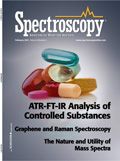Total Reflectance X-Ray Fluorescence Spectroscopy
X-ray fluorescence spectroscopy (XRF) provides sensitive analysis of the atomic composition of samples. The technique is particularly well-suited for analyzing the elemental range from sodium to uranium, which covers the majority of the metallic elements.
X-ray fluorescence spectroscopy (XRF) provides sensitive analysis of the atomic composition of samples. The technique is particularly well-suited for analyzing the elemental range from sodium to uranium, which covers the majority of the metallic elements. Accommodations can be made to allow XRF to pick up the lighter elements. Some samples can be effectively examined nondestructively, while other samples may require grinding, fusion, or some other form of sample preparation.

2010 T-XRF Industrial Distribution
There are many types of XRF systems, including wavelength-dispersive (WD-XRF), energy dispersive (ED-XRF), thickness/microspot XRF, handheld XRF, and total reflectance XRF (T-XRF). In T-XRF specifically, the geometry of the system is what differentiates T-XRF from other XRF techniques. In T-XRF, the X-ray source is aligned so that the X-rays are incident on the surface of the sample at a very small angle, generally less than 1°. This grazing angle geometry allows the system to produce a relatively high signal-to-noise ratio. Furthermore, X-rays do not penetrate more than a few nanometers into the sample, making T-XRF an excellent technique for analyzing the composition of surfaces.
The T-XRF market accounts for only about 5% of the overall XRF market, but is expected to see annual growth in demand that is consistent with the broader market, at around 7%. Steady growth in the general and environmental testing sector combined with rebounding growth in the semiconductor and electronics industry, which account for nearly half of T-XRF demand, will be the primary drivers of the market.
The foregoing data were extracted and adapted from SDi's Global Assessment Report, 11th Edition. For more information, contact Arkady Hagopian, Senior Business Analyst, Strategic Directions International, Inc., 6242 Westchester Parkway, Suite 100, Los Angeles, CA 90045, (310) 641-4982, fax: (310) 641-8851, e-mail: arkadyh@strategic-directions.com, web site: www.strategic-directions.com.

Raman Reveals Rare Ribbeck Meteorite Clues About Ancient Solar System
May 28th 2025A team of scientists in Poland has unveiled the first detailed structural and magnetic analysis of the Ribbeck meteorite, a recently recovered space rock classified as an aubrite. Using Raman spectroscopy, X-ray diffraction, and advanced magnetic testing, researchers revealed the meteorite's unique mineralogy and its connection to deep space conditions.
Tracking Molecular Transport in Chromatographic Particles with Single-Molecule Fluorescence Imaging
May 18th 2012An interview with Justin Cooper, winner of a 2011 FACSS Innovation Award. Part of a new podcast series presented in collaboration with the Federation of Analytical Chemistry and Spectroscopy Societies (FACSS), in connection with SciX 2012 ? the Great Scientific Exchange, the North American conference (39th Annual) of FACSS.
Fluorescence Spectroscopy Emerges as Rapid Screening Tool for Groundwater Contamination in Denmark
May 21st 2025A study published in Chemosphere by researchers at the Technical University of Denmark demonstrates that fluorescence spectroscopy can serve as a rapid, on-site screening tool for detecting pharmaceutical contaminants in groundwater.
Using Spectroscopy to Understand Hawaii’s Hidden Geology
May 8th 2025Researchers from the University of Nevada, Reno, have conducted the most comprehensive subsurface analysis of Hawaiian shield basalts to date, using advanced spectroscopic and geochemical techniques to reveal short-lived hydrothermal alteration processes and establish a new foundation for future volcanic and geothermal studies.